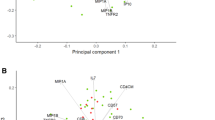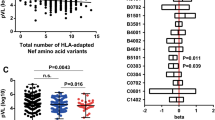Abstract
Although host defense against human immunodeficiency virus 1 (HIV-1) relies mainly on cell-mediated immunity (CMI), the determinants of CMI in humans are poorly understood. Here we demonstrate that variations in the genes encoding the chemokine CCL3L1 and HIV coreceptor CCR5 influence CMI in both healthy and HIV-infected individuals. CCL3L1-CCR5 genotypes associated with altered CMI in healthy subjects were similar to those that influence the risk of HIV transmission, viral burden and disease progression. However, CCL3L1-CCR5 genotypes also modify HIV clinical course independently of their effects on viral load and CMI. These results identify CCL3L1 and CCR5 as major determinants of CMI and demonstrate that these host factors influence HIV pathogenesis through their effects on both CMI and other viral entry–independent mechanisms.
This is a preview of subscription content, access via your institution
Access options
Subscribe to this journal
Receive 12 print issues and online access
$209.00 per year
only $17.42 per issue
Buy this article
- Purchase on Springer Link
- Instant access to full article PDF
Prices may be subject to local taxes which are calculated during checkout






Similar content being viewed by others
References
Douek, D.C., Picker, L.J. & Koup, R.A. T cell dynamics in HIV-1 infection. Annu. Rev. Immunol. 21, 265–304 (2003).
Li, Q. et al. Peak SIV replication in resting memory CD4+ T cells depletes gut lamina propria CD4+ T cells. Nature 434, 1148–1152 (2005).
Rodriguez, B. et al. Predictive value of plasma HIV RNA level on rate of CD4 T-cell decline in untreated HIV infection. J. Am. Med. Assoc. 296, 1498–1506 (2006).
Pandrea, I. et al. Paucity of CD4+CCR5+ T cells is a typical feature of natural SIV hosts. Blood 109, 1069–1076 (2007).
Moore, J.P., Kitchen, S.G., Pugach, P. & Zack, J.A. The CCR5 and CXCR4 coreceptors–central to understanding the transmission and pathogenesis of human immunodeficiency virus type 1 infection. AIDS Res. Hum. Retroviruses 20, 111–126 (2004).
Lederman, M.M., Penn-Nicholson, A., Cho, M. & Mosier, D. Biology of CCR5 and its role in HIV infection and treatment. J. Am. Med. Assoc. 296, 815–826 (2006).
Nibbs, R.J., Yang, J., Landau, N.R., Mao, J.H. & Graham, G.J. LD78beta, a non-allelic variant of human MIP-1alpha (LD78alpha), has enhanced receptor interactions and potent HIV suppressive activity. J. Biol. Chem. 274, 17478–17483 (1999).
Gonzalez, E. et al. The influence of CCL3L1 gene-containing segmental duplications on HIV-1/AIDS susceptibility. Science 307, 1434–1440 (2005).
Kaslow, R.A., Dorak, T. & Tang, J.J. Influence of host genetic variation on susceptibility to HIV type 1 infection. J. Infect. Dis. 191 Suppl 1, S68–S77 (2005).
Mummidi, S. et al. Genealogy of the CCR5 locus and chemokine system gene variants associated with altered rates of HIV-1 disease progression. Nat. Med. 4, 786–793 (1998).
Mangano, A. et al. Concordance between the CC chemokine receptor 5 genetic determinants that alter risks of transmission and disease progression in children exposed perinatally to human immunodeficiency virus. J. Infect. Dis. 183, 1574–1585 (2001).
Gonzalez, E. et al. Race-specific HIV-1 disease-modifying effects associated with CCR5 haplotypes. Proc. Natl. Acad. Sci. USA 96, 12004–12009 (1999).
Martin, M.P. et al. Genetic acceleration of AIDS progression by a promoter variant of CCR5. Science 282, 1907–1911 (1998).
Hladik, F. et al. Combined effect of CCR5-Delta32 heterozygosity and the CCR5 promoter polymorphism -2459 A/G on CCR5 expression and resistance to human immunodeficiency virus type 1 transmission. J. Virol. 79, 11677–11684 (2005).
Salkowitz, J.R. et al. CCR5 promoter polymorphism determines macrophage CCR5 density and magnitude of HIV-1 propagation in vitro. Clin. Immunol. 108, 234–240 (2003).
Taub, D.D. et al. Beta chemokines costimulate lymphocyte cytolysis, proliferation, and lymphokine production. J. Leukoc. Biol. 59, 81–89 (1996).
Karpus, W.J. et al. Differential CC chemokine-induced enhancement of T helper cell cytokine production. J. Immunol. 158, 4129–4136 (1997).
Zou, W. et al. Macrophage-derived dendritic cells have strong Th1-polarizing potential mediated by beta-chemokines rather than IL-12. J. Immunol. 165, 4388–4396 (2000).
Pinto, L.A., Williams, M.S., Dolan, M.J., Henkart, P.A. & Shearer, G.M. Beta-chemokines inhibit activation-induced death of lymphocytes from HIV-infected individuals. Eur. J. Immunol. 30, 2048–2055 (2000).
Luther, S.A. & Cyster, J.G. Chemokines as regulators of T cell differentiation. Nat. Immunol. 2, 102–107 (2001).
Moser, B. & Loetscher, P. Lymphocyte traffic control by chemokines. Nat. Immunol. 2, 123–128 (2001).
Lillard, J.W., Jr. et al. MIP-1alpha and MIP-1beta differentially mediate mucosal and systemic adaptive immunity. Blood 101, 807–814 (2003).
Molon, B. et al. T cell costimulation by chemokine receptors. Nat. Immunol. 6, 465–471 (2005).
Castellino, F. et al. Chemokines enhance immunity by guiding naive CD8+ T cells to sites of CD4+ T cell–dendritic cell interaction. Nature 440, 890–895 (2006).
Amella, C.A., Sherry, B., Shepp, D.H. & Schmidtmayerova, H. Macrophage inflammatory protein 1alpha inhibits postentry steps of human immunodeficiency virus type 1 infection via suppression of intracellular cyclic AMP. J. Virol. 79, 5625–5631 (2005).
Zhang, Z.Q. et al. The impact of early immune destruction on the kinetics of postacute viral replication in rhesus monkey infected with the simian-human immunodeficiency virus 89.6P. Virology 320, 75–84 (2004).
Bonhoeffer, S., Funk, G.A., Gunthard, H.F., Fischer, M. & Muller, V. Glancing behind virus load variation in HIV-1 infection. Trends Microbiol. 11, 499–504 (2003).
Mellors, J.W. et al. Plasma viral load and CD4+ lymphocytes as prognostic markers of HIV-1 infection. Ann. Intern. Med. 126, 946–954 (1997).
Mellors, J.W. et al. Prognosis in HIV-1 infection predicted by the quantity of virus in plasma. Science 272, 1167–1170 (1996).
Migueles, S.A. et al. HLA B*5701 is highly associated with restriction of virus replication in a subgroup of HIV-infected long term nonprogressors. Proc. Natl. Acad. Sci. USA 97, 2709–2714 (2000).
Altfeld, M. et al. Influence of HLA-B57 on clinical presentation and viral control during acute HIV-1 infection. AIDS 17, 2581–2591 (2003).
Betts, M.R. et al. HIV nonprogressors preferentially maintain highly functional HIV-specific CD8+ T cells. Blood 107, 4781–4789 (2006).
Kim, S. et al. Both serum HIV type 1 RNA levels and CD4+ lymphocyte counts predict clinical outcome in HIV type 1-infected subjects with 200 to 500 CD4+ cells per cubic millimeter. AIDS Clinical Trials Group Study 175 Virology Study Team. AIDS Res. Hum. Retroviruses 16, 645–653 (2000).
Gandhi, R.T. & Walker, B.D. Immunologic control of HIV-1. Annu. Rev. Med. 53, 149–172 (2002).
Birx, D.L. et al. The prognostic utility of delayed-type hypersensitivity skin testing in the evaluation of HIV-infected patients. Military Medical Consortium for Applied Retroviral Research. J. Acquir. Immune Defic. Syndr. 6, 1248–1257 (1993).
Blatt, S.P. et al. Delayed-type hypersensitivity skin testing predicts progression to AIDS in HIV-infected patients. Ann. Intern. Med. 119, 177–184 (1993).
Dolan, M.J. et al. In vitro T cell function, delayed-type hypersensitivity skin testing, and CD4+ T cell subset phenotyping independently predict survival time in patients infected with human immunodeficiency virus. J. Infect. Dis. 172, 79–87 (1995).
Kniker, W.T., Anderson, C.T., McBryde, J.L., Roumiantzeff, M. & Lesourd, B. Multitest CMI for standardized measurement of delayed cutaneous hypersensitivity and cell-mediated immunity. Normal values and proposed scoring system for healthy adults in the U.S.A. Ann. Allergy 52, 75–82 (1984).
Maas, J.J. et al. In vivo delayed-type hypersensitivity skin test anergy in human immunodeficiency virus type 1 infection is associated with T cell nonresponsiveness in vitro. J. Infect. Dis. 178, 1024–1029 (1998).
Gordin, F.M. et al. Delayed-type hypersensitivity skin tests are an independent predictor of human immunodeficiency virus disease progression. Department of Veterans Affairs Cooperative Study Group. J. Infect. Dis. 169, 893–897 (1994).
Smith, A. et al. Does genotype mask the relationship between psychological factors and immune function? Brain Behav. Immun. 19, 147–152 (2005).
Mummidi, S. et al. Evolution of human and non-human primate CC chemokine receptor 5 gene and mRNA. Potential roles for haplotype and mRNA diversity, differential haplotype-specific transcriptional activity, and altered transcription factor binding to polymorphic nucleotides in the pathogenesis of HIV-1 and simian immunodeficiency virus. J. Biol. Chem. 275, 18946–18961 (2000).
Brenchley, J.M., Price, D.A. & Douek, D.C. HIV disease: fallout from a mucosal catastrophe? Nat. Immunol. 7, 235–239 (2006).
Gilbert, P.B. et al. What constitutes efficacy for a human immunodeficiency virus vaccine that ameliorates viremia: issues involving surrogate end points in phase 3 trials. J. Infect. Dis. 188, 179–193 (2003).
Abel, L. & Casanova, J.L. Human genetics of infectious diseases: Fundamental insights from clinical studies. Semin. Immunol. 18, 327–329 (2006).
Koning, F.A. et al. Low-level CD4+ T cell activation is associated with low susceptibility to HIV-1 infection. J. Immunol. 175, 6117–6122 (2005).
van Asten, L. et al. Pre-seroconversion immune status predicts the rate of CD4 T cell decline following HIV infection. AIDS 18, 1885–1893 (2004).
Martin, M.P. et al. Innate partnership of HLA-B and KIR3DL1 subtypes against HIV-1. Nat. Genet. 39, 733–740 (2007).
Dunham, R. et al. The AIDS resistance of naturally SIV-infected sooty mangabeys is independent of cellular immunity to the virus. Blood 108, 209–217 (2006).
Duggal, P. et al. The effect of RANTES chemokine genetic variants on early HIV-1 plasma RNA among African American injection drug users. J. Acquir. Immune Defic. Syndr. 38, 584–589 (2005).
Qi, Y. et al. KIR/HLA pleiotropism: protection against both HIV and opportunistic infections. PLoS Pathog 2, e79 (2006).
Fellay, J. et al. A whole-genome association study of major determinants for host control of HIV-1. Science 317, 944–947 (2007).
Kuziel, W.A. et al. CCR5 deficiency is not protective in the early stages of atherogenesis in apoE knockout mice. Atherosclerosis 167, 25–32 (2003).
Acknowledgements
The people and funding agencies that made this work possible are in the Supplementary Note online.
Author information
Authors and Affiliations
Contributions
M.J.D., H.K. and S.K.A. conceptualized the research, conducted statistical analyses, analyzed the data and wrote the manuscript. J.F.C., W.H., A.S., J.-M.A., T.M., F.M.H., M.M. and F.P. made substantial and equivalent contributions to experimental data, analysis of data, preparation of the manuscript and/or cohort data. V.M., A.M., L.S., R.B., R.A.C., S.A.A., J.D., R.J.O., A.L., J.M., S.S.A., B.K.A., B.D.W. and S.G.D. also provided cohorts and data, important conceptual ideas and contributed to the preparation of the manuscript. M.J.D. and S.K.A. directed the study and obtained the funding for the genetic work.
Corresponding authors
Supplementary information
Supplementary Text and Figures
Supplementary Figures 1–13, Tables 1–9, Methods and Note (PDF 2179 kb)
Rights and permissions
About this article
Cite this article
Dolan, M., Kulkarni, H., Camargo, J. et al. CCL3L1 and CCR5 influence cell-mediated immunity and affect HIV-AIDS pathogenesis via viral entry-independent mechanisms. Nat Immunol 8, 1324–1336 (2007). https://doi.org/10.1038/ni1521
Received:
Accepted:
Published:
Issue Date:
DOI: https://doi.org/10.1038/ni1521
This article is cited by
-
CCR5 blockade for neuroinflammatory diseases — beyond control of HIV
Nature Reviews Neurology (2016)
-
Influence of intragenic CCL3 haplotypes and CCL3L copy number in HIV-1 infection in a sub-Saharan African population
Genes & Immunity (2013)
-
Spontaneous virologic suppression in HIV controllers is independent of delayed-type hypersensitivity test responsiveness
AIDS Research and Therapy (2012)
-
Functional effects of CCL3L1 copy number
Genes & Immunity (2012)
-
Genetic Knockouts Suggest a Critical Role for HIV Co-Receptors in Models of HIV gp120-Induced Brain Injury
Journal of Neuroimmune Pharmacology (2012)



